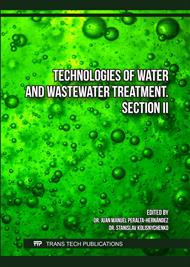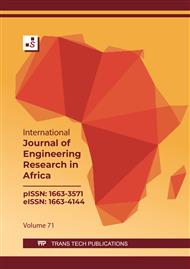[1]
Buyle M, Braet J, Audenaert A (2013) Life cycle assessment in the construction sector: A review. Renew Sustain Energy Rev 26:379–388
DOI: 10.1016/j.rser.2013.05.001
Google Scholar
[2]
Zhang X, Shen L, Zhang L (2013) Life cycle assessment of the air emissions during building construction process: A case study in Hong Kong. Renew Sustain Energy Rev 17:160–169
DOI: 10.1016/j.rser.2012.09.024
Google Scholar
[3]
Seo S, Hwang Y (2001) Estimation of CO 2 Emissions in Life Cycle of Residential Buildings. J Constr Eng Manag 127:414–418. https://doi.org/10.1061/(ASCE)0733-9364 (2001) 127: 5(414)
DOI: 10.1061/(asce)0733-9364(2001)127:5(414)
Google Scholar
[4]
Yan H, Shen Q, Fan LCH, et al (2010) Greenhouse gas emissions in building construction: A case study of One Peking in Hong Kong. Build Environ 45:949–955
DOI: 10.1016/j.buildenv.2009.09.014
Google Scholar
[5]
Textes réglementaires. https://www.mem.gov.ma/Pages/TextesReglementaires.aspx. Accessed 30 Jun (2023)
Google Scholar
[6]
Gray M, Zarnikau J (2011) Getting to Zero. In: Energy, Sustainability and the Environment. Elsevier, p.231–271
DOI: 10.1016/b978-0-12-385136-9.10009-9
Google Scholar
[7]
Rathore PKS, Shukla SK, Gupta NK (2020) Yearly analysis of peak temperature, thermal amplitude, time lag and decrement factor of a building envelope in tropical climate. J Build Eng 31:101459
DOI: 10.1016/j.jobe.2020.101459
Google Scholar
[8]
Asadi I, Hashemi M, Sajadi B, et al (2023) Evaluating the time lag and decrement factor of mortar and concrete containing OPBC as an agricultural by-product lightweight aggregate. Case Stud Therm Eng 41:102609
DOI: 10.1016/j.csite.2022.102609
Google Scholar
[9]
Quagraine KA, Ramde EW, Fiagbe YAK, Quansah DA (2020) Evaluation of time lag and decrement factor of walls in a hot humid tropical climate. Therm Sci Eng Prog 20:100758
DOI: 10.1016/j.tsep.2020.100758
Google Scholar
[10]
Sun C, Shu S, Ding G, et al (2013) Investigation of time lags and decrement factors for different building outside temperatures. Energy Build 61:1–7
DOI: 10.1016/j.enbuild.2013.02.003
Google Scholar
[11]
Jin X, Zhang X, Cao Y, Wang G (2012) Thermal performance evaluation of the wall using heat flux time lag and decrement factor. Energy Build 47:369–374
DOI: 10.1016/j.enbuild.2011.12.010
Google Scholar
[12]
Lu Y, Hu J, Yu J, et al (2024) Analytical solutions for decrement factor and phase shift of wall under periodic fluctuation of outdoor air temperature. Appl Therm Eng 242:122487
DOI: 10.1016/j.applthermaleng.2024.122487
Google Scholar
[13]
Limami H, Manssouri I, Cherkaoui K, et al (2020) Thermal performance of unfired lightweight clay bricks with HDPE & PET waste plastics additives. J Build Eng 30:101251
DOI: 10.1016/j.jobe.2020.101251
Google Scholar
[14]
Asan H (2006) Numerical computation of time lags and decrement factors for different building materials. Build Environ 41:615–620
DOI: 10.1016/j.buildenv.2005.02.020
Google Scholar
[15]
Allam B, Nehari T, Benlekkam ML (2023) Building brick wall thermal management optimization and temperature control based on phase change materials integration. Case study of the city of Bechar, Algeria. J Energy Storage 73:109043
DOI: 10.1016/j.est.2023.109043
Google Scholar
[16]
Dlimi M, Iken O, Agounoun R, et al (2018) Experimental and numerical investigations on the thermal performance of hemp such a bio-sourced insulation material: application to a Moroccan Mediterranean climate. Int J Eng Technol 7:157–164
DOI: 10.14419/ijet.v7i1.9090
Google Scholar
[17]
Limami H, Manssouri I, Cherkaoui K, Khaldoun A (2021) Recycled wastewater treatment plant sludge as a construction material additive to ecological lightweight earth bricks. Clean Eng Technol 2:100050
DOI: 10.1016/j.clet.2021.100050
Google Scholar
[18]
du Maroc: Stratégie Nationale de Développement... - Google Scholar. https://scholar.google.com/scholar_lookup?title=Strat%C3%A9gie%20National%20de%20D%C3%A9veloppement%20Durable%20(SNDD)%202030%2C%20R%C3%A9sum%C3%A9%20Executif&author=SNDD&publication_year=2018. Accessed 30 Jun (2023)
DOI: 10.9737/hist.2018.617
Google Scholar
[19]
Rabie GM, El-Halim HA, Rozaik EH (2019) Influence of using dry and wet wastewater sludge in concrete mix on its physical and mechanical properties. Ain Shams Eng J 10:705–712
DOI: 10.1016/j.asej.2019.07.008
Google Scholar
[20]
Search results for " " | https://www.imanor.gov.ma/name. https://www.imanor.gov.ma/ ?keyword-type=course_id&s=NM+01. Accessed 30 Jun (2023)
Google Scholar
[21]
Kadir AA, Salim NSA, Nawi NM, Sandu AV (2017) Properties Impact From Wastewater Treatment Sludge Utilized Into Fired Clay Bricks. 2:
Google Scholar
[22]
Limami H, Manssouri I, Cherkaoui K, Khaldoun A (2021) Physicochemical, mechanical and thermal performance of lightweight bricks with recycled date pits waste additives. J Build Eng 34:101867
DOI: 10.1016/j.jobe.2020.101867
Google Scholar
[23]
Tay J-H (1986) Potential use of sludge ash as construction material. Resour Conserv 13:53–58
DOI: 10.1016/0166-3097(86)90006-4
Google Scholar
[24]
Du MARoc: Bulletin Officiel - Google Scholar. https://scholar.google.com/ scholar_lookup? title=Bulletin%20Officiel&author= B.%20Officiel&publication_year=1993. Accessed 30 Jan (2023)
Google Scholar
[25]
Pawlowski B, Krawczyk J, Bala P (2013) The Premature Deterioration of Zinc‐coated Steel Pipes in Water Distribution System. Int J Mater Mech Eng 2:
Google Scholar
[26]
Normes | IMANOR | Page 97. https://www.imanor.gov.ma/normes/page/97/. Accessed 13 Feb (2023)
Google Scholar
[27]
Walker R, Pavía S, Dalton M (2016) Measurement of moisture content in solid brick walls using timber dowel. Mater Struct 49:2549–2561
DOI: 10.1617/s11527-015-0667-6
Google Scholar
[28]
Wu Q, Wang J, Meng X (2021) Influence of wall thermal performance on the contribution efficiency of the Phase-Change Material (PCM) layer. Case Stud Therm Eng 28:101398
DOI: 10.1016/j.csite.2021.101398
Google Scholar
[29]
Guo Z, Shi X (2011) Temperature–Time Curve of Fire and the Equation of Heat Conduction. In: Experiment and Calculation of Reinforced Concrete at Elevated Temperatures. Elsevier, p.76–90
DOI: 10.1016/b978-0-12-386962-3.10005-1
Google Scholar
[30]
Shafigh P, Asadi I, Mahyuddin NB (2018) Concrete as a thermal mass material for building applications - A review. J Build Eng 19:14–25
DOI: 10.1016/j.jobe.2018.04.021
Google Scholar



